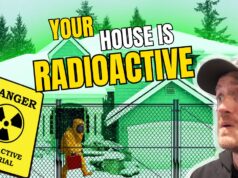Like it or not, fall is here which means winter will be follow soon behind! Unfortunately, the winter months are often the time when you find out what issues your house is currently dealing with. Before you find yourself with a winter headache, I thought I’d put together a checklist of things you might want to do now that can make sure you and your home is prepped for the long winter months ahead!
DIY Fall Homeowner Checklist: 10 Things You Need to Be Doing Now!
1.) Change Your HVAC Filters
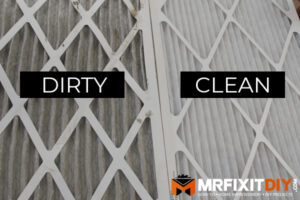 If I sound like a broken record about this it’s because it’s one of the simplest and beneficial things you can do for your heating & air conditioning system. So many potentially problematic issues can be avoiding if you just change your filters out regularly. (Every 3 months if you can) For more info on the benefits of changing your filters regularly, check out this previous article I wrote.
If I sound like a broken record about this it’s because it’s one of the simplest and beneficial things you can do for your heating & air conditioning system. So many potentially problematic issues can be avoiding if you just change your filters out regularly. (Every 3 months if you can) For more info on the benefits of changing your filters regularly, check out this previous article I wrote.
2.) Flush Your Hot Water Tank
I’m always surprised by how many homeowners I talk to that have never drained and flushed their hot water tank. Understandable I suppose, it’s not something you learn about in school. Flushing your water tank is really simple and it helps prolong the life of the tank. Over time, lime, calcium, and other minerals in your water can create deposits in the tank. (Especially if you have hard water) Periodically draining your water tank doesn’t allow those sediments to build up and cause problems with the heating elements that can shorten the life of the tank. The middle of the winter is the worst time to not have hot water in your home!
 While you’re at it, it’s not a bad idea to turn the water temperature down on your tank a few degrees. Warm water in the winter months feels warmer as the air is cooler. Save yourself some energy costs by decreasing the temperature a little bit. You won’t notice and it’ll help your wallet.
While you’re at it, it’s not a bad idea to turn the water temperature down on your tank a few degrees. Warm water in the winter months feels warmer as the air is cooler. Save yourself some energy costs by decreasing the temperature a little bit. You won’t notice and it’ll help your wallet.
3.) Clean Your Gutters
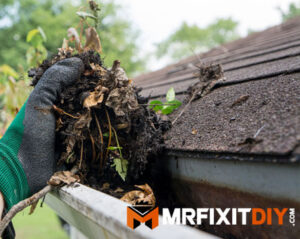 This is a big one! Cleaning gutters makes sure that your gutters are working properly and can drain the water away from your house as snow, rain, and ice freeze and thaw. If you don’t have clean gutters, water can turn to ice and build up in the gutters which can build into ice dams that can get under your roof and cause major water damage inside. Not only that but gutters that are frozen solid can get really heavy and separate from the house which can fall and cause major problems. A quick cleaning can save you a lot of potential headache.
This is a big one! Cleaning gutters makes sure that your gutters are working properly and can drain the water away from your house as snow, rain, and ice freeze and thaw. If you don’t have clean gutters, water can turn to ice and build up in the gutters which can build into ice dams that can get under your roof and cause major water damage inside. Not only that but gutters that are frozen solid can get really heavy and separate from the house which can fall and cause major problems. A quick cleaning can save you a lot of potential headache.
4.) Seal Drafts
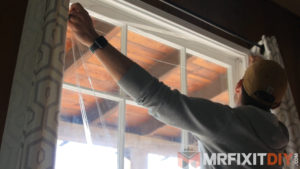 A drafty house in the winter is no fun. Finding leaky areas now and sealing them up not only keeps your house more comfortable in the winter months, but can also save you big money on your energy bill. Common culprits of drafts in your home are around electrical outlets, worn out weather stripping on doors, and older single pane windows. For more tips on how to seal up drafts, areas to target, and ways to save on energy costs this winter check out this article.
A drafty house in the winter is no fun. Finding leaky areas now and sealing them up not only keeps your house more comfortable in the winter months, but can also save you big money on your energy bill. Common culprits of drafts in your home are around electrical outlets, worn out weather stripping on doors, and older single pane windows. For more tips on how to seal up drafts, areas to target, and ways to save on energy costs this winter check out this article.
5.) Winterize Your Pipes
 If you’re in an area that freezes, it’s time to winterize your pipes. Any outdoor plumbing like sprinkler systems need to be drained of any water that could potentially freeze and cause a rupture. Any hose bibs or piping that sticks up from the ground should be wrapped with insulating pipe tape or insulating foam and UV Proof tape.
If you’re in an area that freezes, it’s time to winterize your pipes. Any outdoor plumbing like sprinkler systems need to be drained of any water that could potentially freeze and cause a rupture. Any hose bibs or piping that sticks up from the ground should be wrapped with insulating pipe tape or insulating foam and UV Proof tape.
Inside the house it’s also not a bad idea to wrap any water lines or piping that runs through the foundation, sills, or is in close proximity to exterior walls. If you commonly battle freezing pipes in the winter you’re likely familiar with trouble spots. Wrapping pipes helps insulate to prevent freezing.
Ruptured pipes can cause big problems both inside and out. Do yourself a favor and spend a few minutes now and potentially save yourself a huge headache.
 If you want to save yourself a hassle of draining exterior hose bibs down the line, consider updating to a House Hydrant from Aquor Water Systems.
If you want to save yourself a hassle of draining exterior hose bibs down the line, consider updating to a House Hydrant from Aquor Water Systems.
6.) Clean & Fertilize Your Lawn
 Homeowners commonly overlook their lawn when preparing their homes for winter, but a simple winterizing fertilizer can help your lawn rebound quickly come the spring. Do your best to rake any leaves and debris around the lawn and apply a winterizing fertilizer all around the lawn. There are a ton of great products out there, but a slow release, nitrogen rich fertilizer will continue to feed your lawn all winter long. Make sure your lawn and home are prepped for winter and ready for spring.
Homeowners commonly overlook their lawn when preparing their homes for winter, but a simple winterizing fertilizer can help your lawn rebound quickly come the spring. Do your best to rake any leaves and debris around the lawn and apply a winterizing fertilizer all around the lawn. There are a ton of great products out there, but a slow release, nitrogen rich fertilizer will continue to feed your lawn all winter long. Make sure your lawn and home are prepped for winter and ready for spring.
7.) Fix Chips and Cracks in Concrete
 If you have a crack in your driveway, sidewalk, foundation, or walkway going into the winter months you can bet that it’ll be worse come the spring! Frost heave is a nightmare for concrete cracks. Water penetrates the crack, freezes and expands, and then lifts and separates the crack even more. If there’s a spot where this can happen around your home it 100% will happen. You’ll be left with a bigger mess to deal with in the spring. Look around your home and make the small fix now before it turns into a bigger fix later.
If you have a crack in your driveway, sidewalk, foundation, or walkway going into the winter months you can bet that it’ll be worse come the spring! Frost heave is a nightmare for concrete cracks. Water penetrates the crack, freezes and expands, and then lifts and separates the crack even more. If there’s a spot where this can happen around your home it 100% will happen. You’ll be left with a bigger mess to deal with in the spring. Look around your home and make the small fix now before it turns into a bigger fix later.
8.) Tune up Your Small Engines

Now is the time to do all the small engine repairs and maintenance on your snowblower, lawnmower, and make sure your snow shovels are in good shape. Doing basic maintenance on your small engine items like oil & filter changes, carburetor cleaning, and air filter changes can make sure those machines are ready to go when you need them. Tuning up your snowblower may seem an obvious one but doing end of season maintenance on your lawnmower also makes sure it’s good to be stored for the winter and will be ready to go when the spring rolls around.
9.) Have Your Chimneys Cleaned and Inspected
 There’s nothing better than sitting around a fire on a blustery winter night but they’re also a leading cause of house fires every year. In fact there are over 25,000 chimney fires every year in the United States. These fires cause hundreds of millions of dollars in damages each year. Making sure your chimney is clean is a critical part of making sure your home is prepped for winter.
There’s nothing better than sitting around a fire on a blustery winter night but they’re also a leading cause of house fires every year. In fact there are over 25,000 chimney fires every year in the United States. These fires cause hundreds of millions of dollars in damages each year. Making sure your chimney is clean is a critical part of making sure your home is prepped for winter.
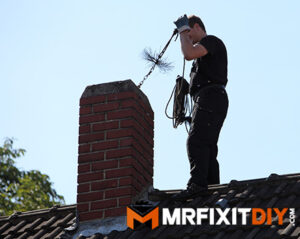 As fires burn, a dark tar like substance called creosote is formed from the combustion process. It builds up and condenses on the walls of the chimney over time. If not cleaned regularly, this buildup can reach a highly flammable threshold. Once a fire is lit and reaches the creosote lined chimney, it will quickly ignite and be extremely difficult to extinguish and contain. These fires can easily spread to other areas of the home and are extremely dangerous.
As fires burn, a dark tar like substance called creosote is formed from the combustion process. It builds up and condenses on the walls of the chimney over time. If not cleaned regularly, this buildup can reach a highly flammable threshold. Once a fire is lit and reaches the creosote lined chimney, it will quickly ignite and be extremely difficult to extinguish and contain. These fires can easily spread to other areas of the home and are extremely dangerous.
Click here to learn how you can clean the chimney yourself. Or you can hire a professional to typically clean your chimney for around $200-$500. Find a certified chimney sweep in your area.
10.) Check Your Smoke Alarms and Carbon Monoxide Detectors
 Whether you have hard wired or battery smoke alarms and CO Detectors make sure they are working properly by testing them. Make sure the batteries are changed and working. For hardwired units, use the test button to make sure they’re working properly.
Whether you have hard wired or battery smoke alarms and CO Detectors make sure they are working properly by testing them. Make sure the batteries are changed and working. For hardwired units, use the test button to make sure they’re working properly.
Carbon monoxide is caused by the incomplete burning of fuels including natural gas, oil, coal, propane, and wood. Carbon monoxide is a tasteless, odorless, and potentially fatal gas. It can quickly become a problem in a closed up winter home without adequate air flow. Many of the mechanicals in our homes are powered by one of the fuels that cause carbon monoxide poisoning. Make sure you have the added protection of a quality detector for the safety of you and your loved ones.
For more information about the dangers of carbon monoxide, check out this article by the CDC.
I hope you enjoy this content and I hope it helps you get your home prepped for winter!
To view all my recommended tools, and winterizing products, make sure you visit my Amazon storefront.
Here are a few other articles and DIY home maintenance tips you may enjoy.




